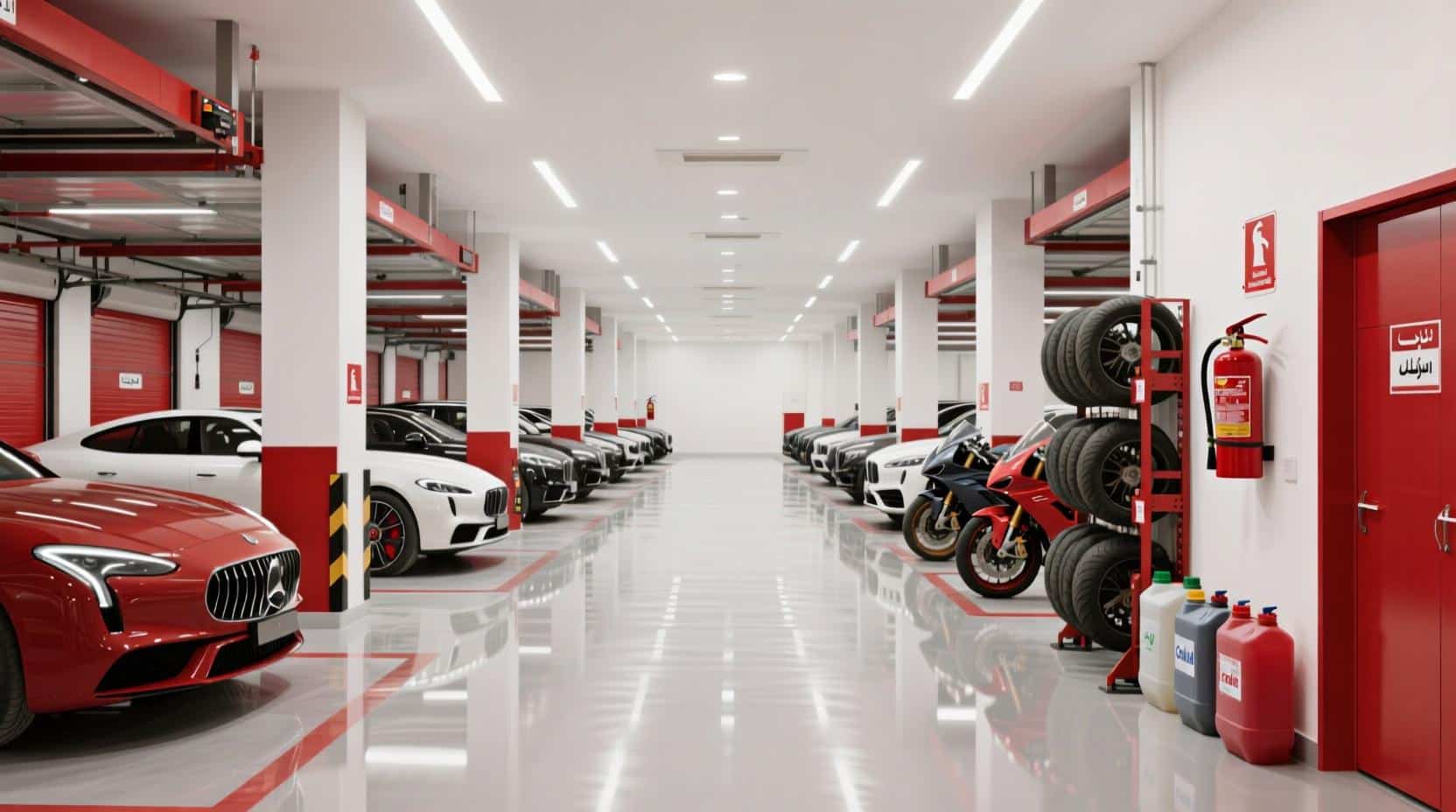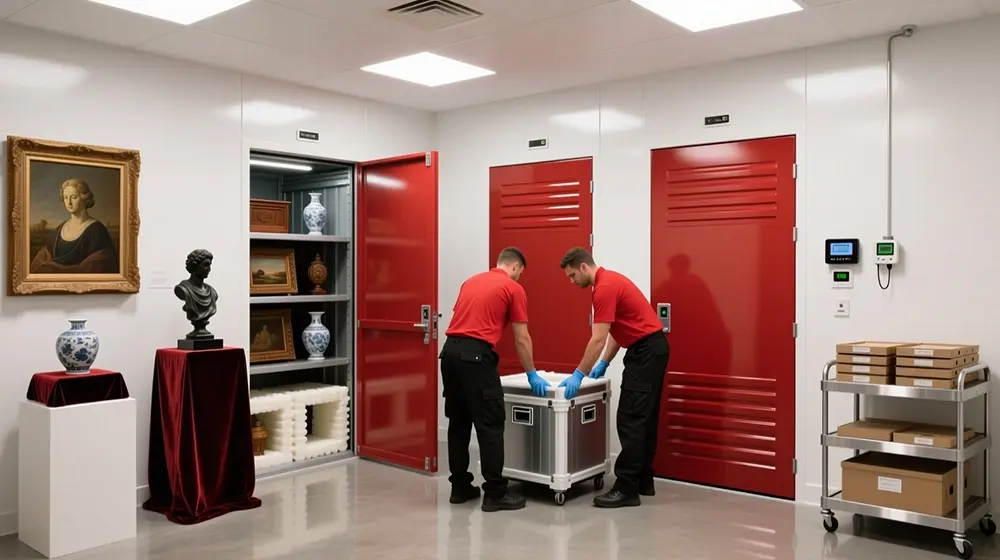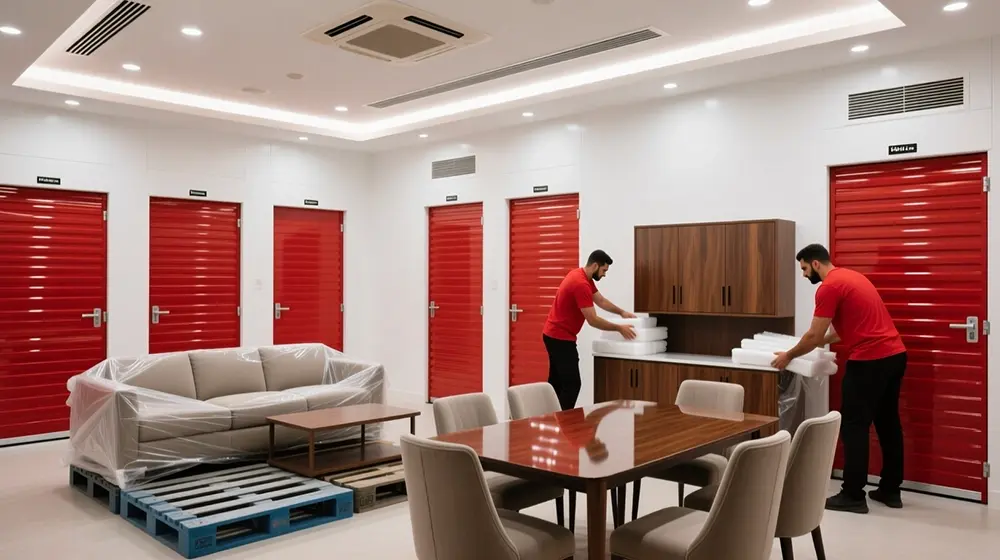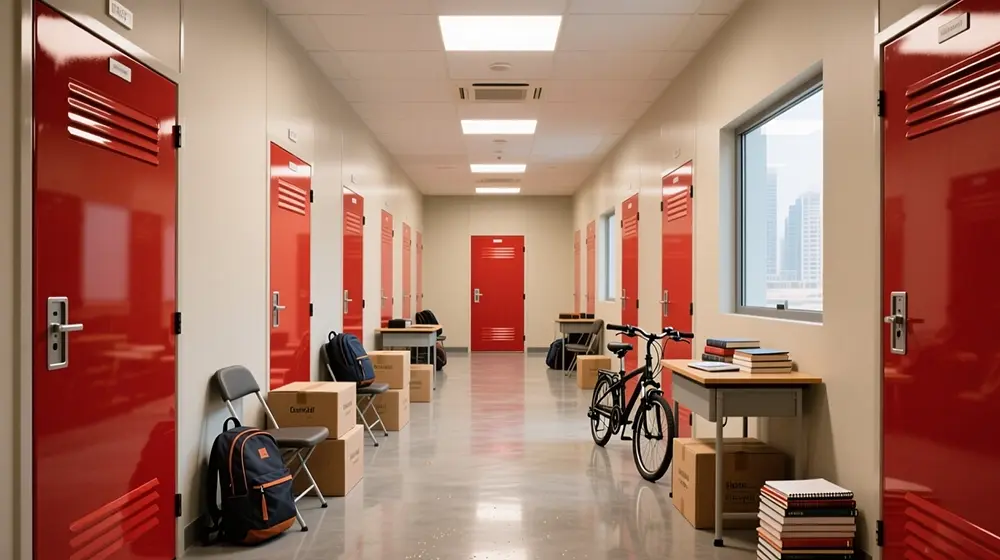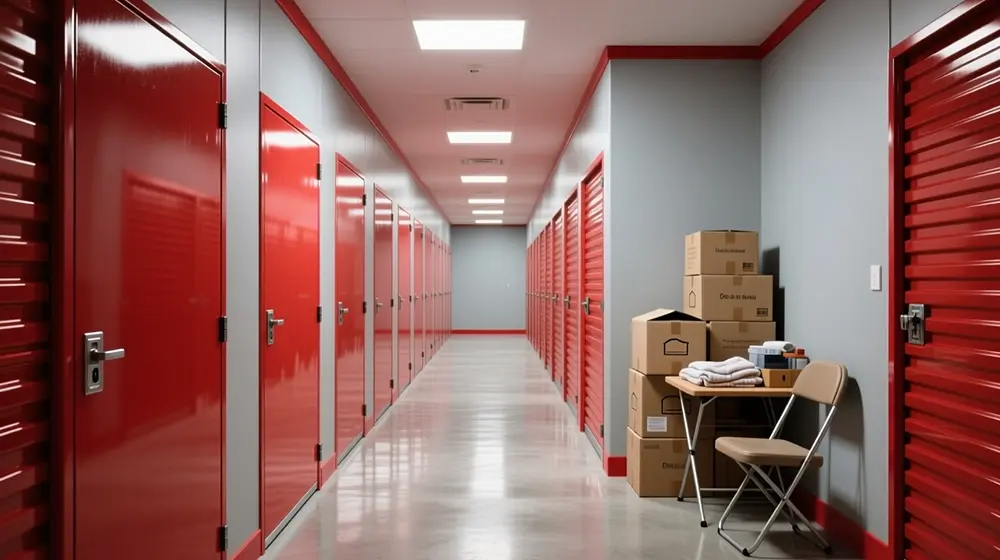The United Arab Emirates is a place where owning a car or a motorbike is a need and an obsession. Vehicles are a significant aspect of everyday life, with long commutes, broad highways, and an increasingly popular culture of sport and leisure riding. However, the climate of the UAE is quite different. The heat can reach highs of over 45 OC in the daytime in blazing summers, and humidity rises over coastal regions, and sandstorms cover the desert. These environments are harsh to any idle vehicle.
Also Read : Is Self Storage in Dubai Sustainable? Exploring the Environmental and Economic Benefits
A lot of inhabitants also go outside the country on a long holiday, particularly during the summer holidays. Expatriates usually leave their cars parked for weeks or months when they go on holiday to see family members. There are others who move temporarily due to work or personal reasons. Under these circumstances, secure vehicle storage is more than a luxury; it is a good investment and a preservation of the environment.
As compared to other regions with milder climates, parking a car or a motorcycle in a shaded region is not sufficient in the UAE. Heat drains batteries, dries tyres, causes corrosion faster, and may even heighten fire hazards when it comes to hazardous materials that are not stored correctly. Dust and sand are constant in the area and find their way into air filters, clutches, and moving components. With the more exposed motorcycles, the effect is even worse.
In addition to the physical risks, storage should also address the UAE Civil Defence regulations. Batteries, fuels, and oils are also hazardous materials that are highly restricted. Storage facilities and workshops must also have fire suppression systems, sign,s and personal protective equipment. In the case of an individual owner, this implies a selection of storage options that not only secure the vehicle but also follow local safety measures.
This blog is a detailed guide on how the UAE vehicle owners can store a sports car, SUV, or motorcycle correctly by discussing the ways to maintain the batteries, tyres, and fluids in good condition throughout the storage. It also examines fire-safety concerns, lithium-ion battery standards, and sensible measures to store a motorcycle during the harsh summer seasons. It is also intended to blend informal practical tips with the formal safety framework, so the reader will go away with concrete steps and an idea as to why they are important..
Batteries: The Lifeline of Vehicle Storage
A battery is nearly always the cause when a car has not been used in a few weeks, and the engine will not start. In the extreme heat of the UAE, where temperatures rapidly increase as chemical decay progresses, battery care is the most crucial factor in providing reliable long-term storage.
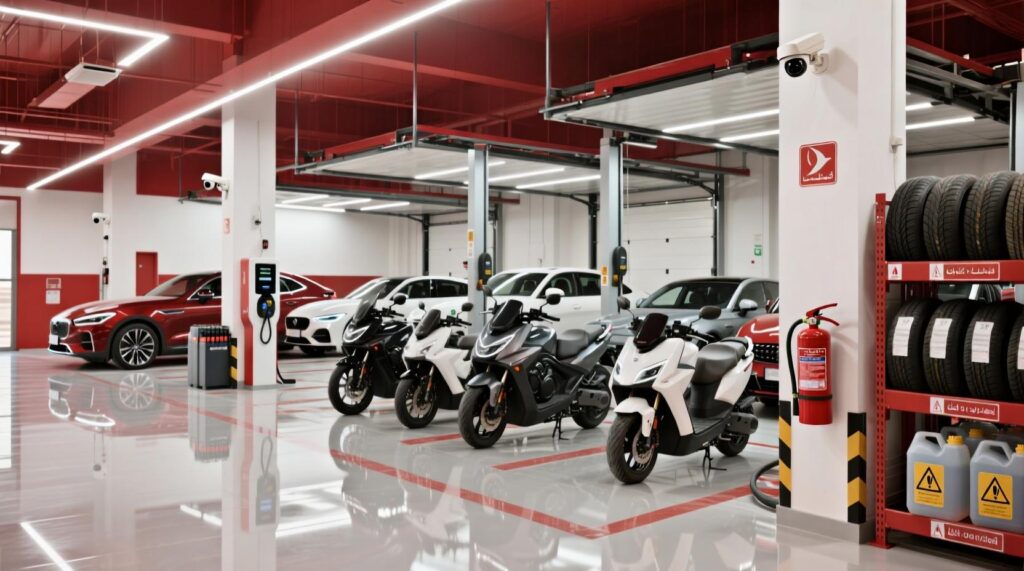
The science of battery degradation in hot climates
The most used type of battery in traditional vehicles is lead-acid, which is based on sulfuric acid and water. When it is hot, the water evaporates more quickly, leaving lead plates bare, which lose their capacity to hold on to a charge. Whereas it may take six months in Europe or North America, it may only take a few weeks in Dubai or Abu Dhabi.
Lithium-ion batteries, which are becoming more common in electric vehicles (EVs) and hybrids, are sensitive as well. Thermal runaway is a chain reaction of heat that can cause internal temperatures to get out of control, resulting in swelling, leakage, or even fire. This risk is not taken seriously by EV owners who think sophisticated management systems will keep the battery safe forever. But storage, without due precautions, is unsafe.
Common mistakes vehicle owners make in UAE
- Leaving the battery connected
Onboard electronics burn power even when not being used. This is faster in hot weather and the battery becomes flat.
- Parking outdoors in direct sun
The heat under the hood can reach very high above ambient temperature, baking the battery internally.
- Using the wrong charger
Most owners attach a conventional charger that can overcharge and kill the battery.
- Ignoring manufacturer advice
Certain high-performance or EV batteries have maintenance procedures that owners do not follow.
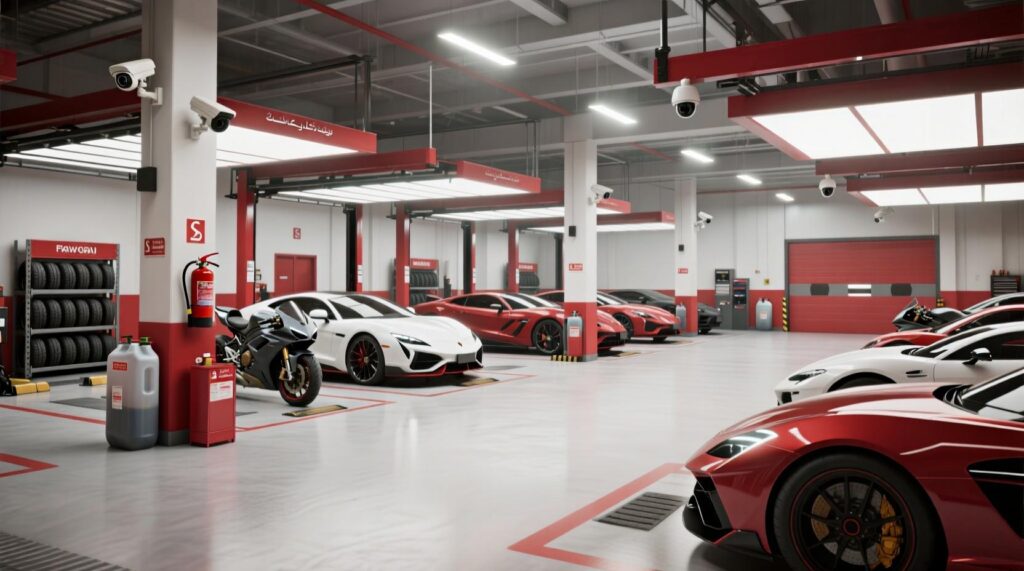
Battery tenders: A simple but essential tool
Most of these issues are solved by a battery tender or smart trickle charger. A tender does not always apply constant current as old chargers do, but rather measures voltage and applies only the necessary current. This not only stops overcharging, but also sulfation of lead-acid batteries and lithium-ion batteries within safe limits.
In the case of motorcycles, a tender is especially critical since their batteries discharge at a higher rate due to their smaller size. Unless it is used, riders who go away in the summer will come back with a totally dead battery.
UAE workshop rules on battery safety
Abu Dhabi technical specification ADS-017-2017 identifies a few rules, applicable to all professional workshops, which are also applicable when it comes to personal storage:
- The batteries should be stored on wooden platforms, which are not in direct contact with the floor.
- Any battery that leaks or that is damaged should be removed and disposed of at once.
- Massive stores must have their own storage room, which is well ventilated and fire resistant.
These control fire risks and environmental pollution. To the layperson, the lesson is straightforward: Do not leave a battery in a poor state of repair and keep it clean and in a well-ventilated, high, and clean area.
Lithium-ion batteries: A regulated hazard in the UAE
Lithium-ion batteries are not only a challenge as an engineering problem, they are a legal problem. Being categorized as ADR Class 9 dangerous goods in the world, storage and transportation is highly restricted.
Key compliance points include:
- Classification:
UN 3480 — lithium-ion batteries not in equipment.
UN 3481 — lithium-ion batteries within or with equipment.
Packaging: Non-conductive hard outer packaging which prevents puncture, crushing or short-circuit.
Charge limits: Battery should be shipped at a state of charge of 30 percent or less.
Documentation: Documentation of Dangerous Goods, Material Safety Data sheets, packing lists, and customs permits are obligatory.
Testing: prior to shipping, batteries undergo UN 38.3 safety tests.
Compliance in the UAE is subject to a number of bodies:
- GCAA (General Civil Aviation Authority): Provides safety of air transport.
- Federal Customs Authority: It implements import/export regulations.
- Local municipalities: Control storage and handling in the emirates.
Also, handlers are required to be trained by IATA. This makes all the people in the chain aware of the dangers and the steps involved in lithium batteries.
Practical tips for UAE owners
- When leaving for over a month, do not leave the negative terminal engaged or apply a tender.
- With motorcycles, the battery should be removed completely and kept somewhere in a cool, dry environment.
- Do not leave EVs with a full charge of the battery; strive to charge to 50-70 percent to minimize stress.
- Always keep batteries in a place that is not flammable.
- Guidelines on checking manufacturers, particularly in new EVs, that might need software settings to store over time.
Tyres: Storage, Ageing, and Fire Hazards in the UAE
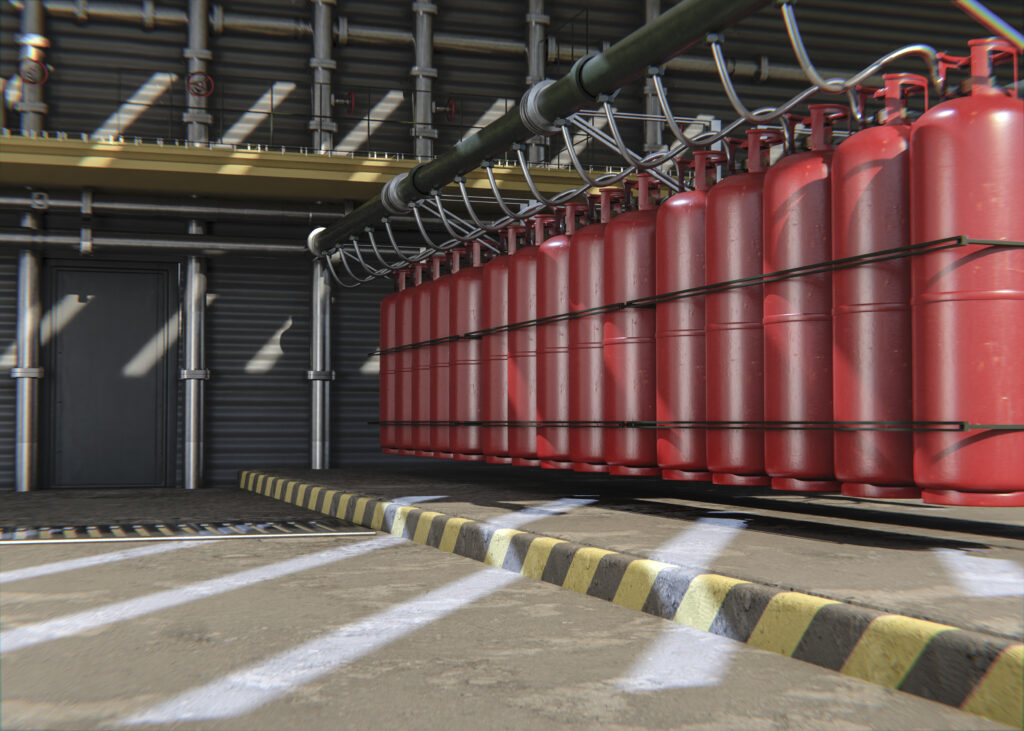
Why tyres demand attention in storage
Tyres are not the first thing that comes to the mind when individuals consider vehicle storage. Owners are concerned with batteries and fluids but think that tyres will just sit down. As a matter of fact, tyres contribute to one of the most vulnerable components of a motorcycle or vehicle when storing it on a long-term basis, especially in the UAE.
Tyres lose air pressure and get flat spots due to heat, direct sunlight, and load standing still. Rubber compounds stiffen and break, making them less grippy and less safe. And although tyres are very difficult to set on fire, when they do, they are a big fire risk as they give off poisonous smoke and a lot of heat.
These risks are enhanced by the environment of the UAE. The pavements and the tarmac can get much hotter than the surrounding air, particularly in summer. Cars parked on the street can have their tyres resting on surfaces at 60-70degC hours at a time. The rubber is also dried by sand and dust, which causes ageing. Tyre condition is critical in the case of motorcycles, which depend on smaller contact patches to achieve safety.
Michelin’s insights into tyre fire hazards
Michelin Middle East has published detailed guidance on tyre fire risks. Key points include:
- Combustion properties:
- Tyres require a strong ignition source, but once lit, they burn fiercely.
- Flash point: 288°C.
- Auto-ignition: 315°C.
- Heat value: 24–30 MJ/kg, meaning they release huge amounts of energy.
- Smoke composition:
Burning tyres produce thick black smoke containing:- Carbon oxides.
- Hydrocarbons (including polycyclic aromatic hydrocarbons).
- Nitrogen oxides.
- Halogenated acids.
- Soot and unburned materials.
- Special risk with acoustic tyres:
Polyurethane foam strips are inserted in these tyres to minimise road noise. The foam burns quickly than normal rubber and generates up to 2,000 cubic metres of toxic, flammable smoke per kilogram. When it is in a basement or even in a garage underground, this smoke may render the air unbearable in just a few minutes.
How tyres should be stored safely
In order to minimize risks, the storage of the tyres should be based on some principles:
- Cool, ventilated places: Tyres must never be stored in the open sun or inside hot rooms. Ventilation will decrease the concentration of heat and vapours.
- No work or smoking around: Welding, grinding, or even a lit cigarette can start fires in the correct circumstances.
- Chemicals to avoid: Tyres are sensitive to solvents, oils, greases, acids, and disinfectants. Exposure to them can cause the rubber to be weak and fire-prone.
- Avoid the basement: It is unsafe to keep tyres underground as the smoke will go up through the levels of the building. In the case of acoustic tyres, storage at the ground floor (even in multi-storey buildings) is discouraged.
- Avoid hot objects: The stacks of tyres should not be close to heat sources, such as radiators, pipes of heating systems, and hot surfaces.
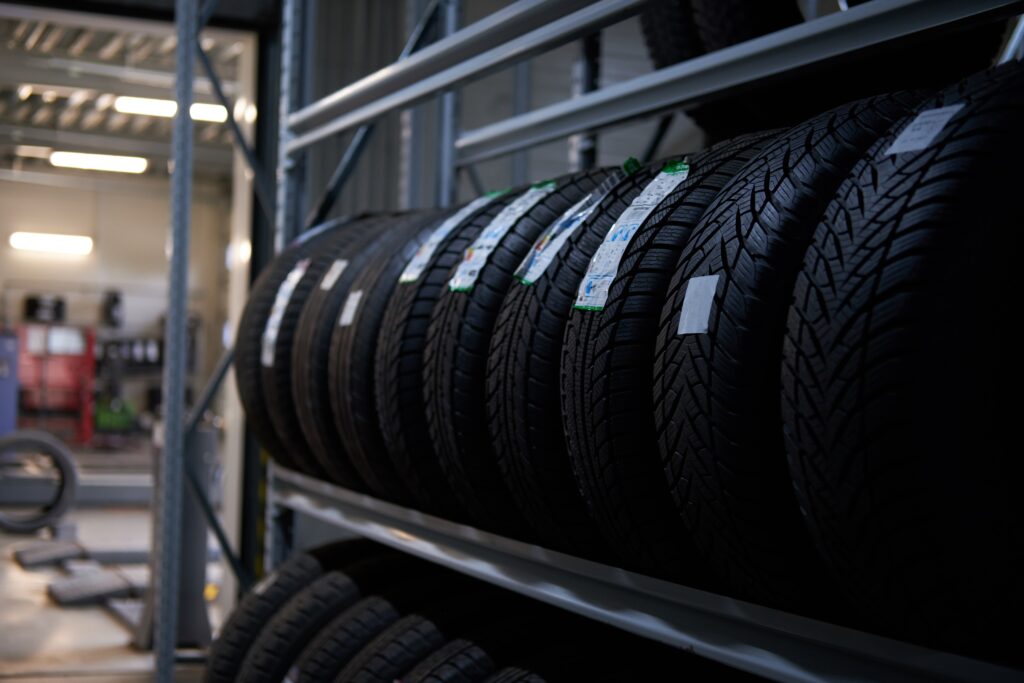
Emergency procedures in case of a tyre fire
In the very improbable but hazardous tyre fire:
- Apply plenty of water as the main extinguishing medium. As a supplement, foam can be used.
- Powder extinguishers can be used to bring down flames in the first place, but they cannot do it alone.
- Keep the distance between the hot tyres and the person at a safe distance (5-10 metres). They may burst due to a sudden change in temperature, causing harmful debris to fly around.
- To keep in mind, re-ignition is typical. Tyres that have been extinguished need to be cooled and observed over a period of hours.
- Smoke is very toxic, and firefighters should use self-contained breathing apparatus.
In the case of a personal owner, the message is straightforward since once the tyre fire breaks out, they are to evacuate as fast as possible, leaving the training personnel to deal with the situation.
Tyre ageing in the UAE context
Tyre deterioration is now a major problem in the area even without the fire hazards. The road and transport authority of the UAE (RTA) require change of tyres that are above 5 years of age, with or without treads. That is due to the fact that rubber compounds degrade easily at high temperatures and in the presence of UV. Hardened tread or split sidewalls may lead to high speed blowouts.
This is even more sensitive with motorcycle tyres. Storage is something that riders overlook, and flat spots or dried-out rubber may make the first post-summer ride unsafe. Motorcycles lack any means of balance except those offered by four tyres; failure in one can be disastrous.
Practical steps for vehicle owners
Prior to storing the car or motorcycle in the UAE:
- Fill tyres to the correct pressure. Tyres that are under-inflated get flat much faster.
- Install a paddock in place of motorcycles to raise the tyres. In the case of cars, it can be wheel cradles or a vehicle shift every two weeks.
- Light breathable cloth cover tyres to keep UV rays out. Do not use plastic covers which trap heat.
- Check manufacturing dates on sidewalls of tyres. Dispose of anything that has not been used in the last five years.
- Before driving after storage, look to see that there were no cracks or bulges.
Why proper tyre storage matters for fire safety
Regulatively speaking, tyres are subject to broader fire-safety regulation in all workshops and warehouses. There should be Civil Defence instructions which entail:
- Rubber-fire extinguishers.
- Well identified evacuation paths.
- Banning of smoking and hot work around storage facilities.
- Employees who are trained to deal with emergencies.
Close attention is also given to insurance companies in the UAE. Insurance can be refused to claim fire damage where facilities fail to meet the Civil Defence standards. In the case of personal storage, this will entail making sure that any storage facility utilized is regulated and has visible extinguishers and signage.
The bigger picture
Compared to the batteries or engines, tyres are a minor issue, however, their role in the safety is massive. They are all that comes into physical contact with the road. They present a not only a maintenance concern but also a fire risk that can put whole facilities at risk when improperly stored.
In the UAE, where the environment is harsh, and the rules and regulations are very strict, it is not a matter of choice to be sensitive about tyres. It concerns a question of safety, conformity, sense.
Vehicle Fluids: Hidden Dangers in Storage
Why fluids matter in long-term storage
All vehicles or motorcycles rely on various fluids in order to operate efficiently. These are fuel, engine oil, coolant, brake fluid and in certain situations, there may be power steering or transmission fluids. They have various purposes, but have one common characteristic; as time goes on, in the climate of the UAE, they degrade and can cause serious damage when not addressed. Worse still, they are also flammable or corrosive and thus a safety issue in storage facilities.
Fluids are rather simple to ignore since they are invisible until something goes wrong. But the most expensive post-storage repairs are associated with forgotten fluids. Moisture is absorbed, clogging the fuel systems, corroding engines internally, and breaking the braking systems. Vehicle owners can prevent the costs of repair as well as the risks associated with the safety of their vehicles by taking precautionary measures before storage.
Fuel: oxidation and stabilisation
As soon as fuel is left in place, it starts to degrade. Volatile compounds are lost in only a few weeks, and the molecules that remain are left to gum up injectors or carburetors. This occurs at a faster rate in the heat of the UAE. Fuels that have ethanol will take in water which will corrode metal components and promote the growth of microbes in tanks.
Best practices of UAE storage:
- Install a fuel stabiliser when the car will not be used in less than one month. This inhibits oxidation and cleans injectors.
- Allow the engine to run a few minutes once the stabiliser has been added so that it circulates through the system.
- Do not store a vehicle with an empty tank – condensation inside the tank may cause rust. A complete tank eliminates lube moisture.
Engine oil: the silent corrosive
- The old engine oil has impurities, including acids, unburnt fuel, and metal particles. Stored in the engine these compounds attack internal parts when they are left inside the engine. The heat in the UAE speeds up the chemical degradation of oil, converting it into sludge at a faster rate.
Best practices:
- Always replace the oil and filter prior to long-term storage. New oil creates a lubricating coating on the engine components.
- Check the oil condition after storage. When the car has been parked for over half a year, it is advisable to change the oil before driving.
Coolant: protection in desert conditions
Not only does coolant ensure that there is no overheating, it also prevents corrosion within the radiator and engine block. The ambient temperatures are very high in the UAE, so the weak coolant may boil, exposing engines to danger.
Best practices:
- Make sure you fill up the coolant to the desired level.
- Change coolant after two years or so because additives wear off with age.
- Before storing, check that there are no leaks, particularly around hoses and the radiator cap.
Brake fluid: absorbing invisible moisture
Brake fluid is hygroscopic, i.e., it absorbs water in the air. This occurs more quickly in a tropical city such as Dubai. As little as a small stream of water will lower the braking performance and increase the chances of vapor lock, which happens when the brakes fail due to heat.
Best practices:
- Every two years, change brake fluid with or without mileage.
- Top up the reservoir before it is put away.
- Test brakes only after storage and with low speed before going back to normal driving.
Transmission and power steering fluids
Though not bulky, these fluids degrade as well. Additives are decomposed by heat and pressure, and minor leaks tend to aggravate when a vehicle is not used. Before being stored, it is always good to check the levels to avoid unpleasant surprises in the future.
UAE regulations for fluid storage (ADS-017-2017)
The Abu Dhabi specification provides a clear arrangement on the manner in which the fluids are to be stored in the workshops:
- The draining of waste oils and fluids should be in industrial standard drums or containers.
- Containers are to be sealed, fireproof, and the contents and danger warnings labeled.
- The hazardous materials shall be in accordance with the Civil Defence classifications on flammability, toxicity, and environmental hazard.
- The expired fluids should be waste that is disposed of in approved hazardous waste channels, but never in the general waste streams.
These rules offer a helpful point of reference to the private car owner. When they are adhered to by a professional facility, owners can be confident that issues of safety and environmental responsibility are being addressed.
Why fluids are a fire and environmental risk
Maintenance is not everything, but safety is everything about fluids. Vapours of petrol are a ready source of fire, used oil is inflammable, and leaks of coolant can corrode electrical installations. Any leaks on hot surfaces can cause fires and poor disposal pollutes soil and water.
Even a small leak in the UAE has disproportionate impact in an environment where storage is commonly conducted within enclosed garages or commercial areas. This is why adherence to the rules is not a choice – it helps protect the environment and people.
Practical checklist for UAE owners before storage
- Change engine oil and filter.
- Add fuel stabiliser and fill up the tank.
- Check hoses and fill up coolant.
- Replace brake fluid when it is due.
- Check and repair leaks before storage.
- Install drip trays beneath the vehicle to receive any small leakages..
Conclusion on fluids
The invisible component of storage is fluids. Not like tyres or batteries, issues are not seen until the vehicle is switched on again, and once a problem has occurred, it may be too late. Adherence to preventive measures and adherence to the strict rules of handling in the UAE will allow car owners to save money on repairs, minimize risks of fire hazards, and adhere to local safety norms.
Fire Safety in UAE Storage & Workshops
Why fire safety matters in vehicle storage
Cars and motorcycles are complicated machinery, loaded with inflammable substances: fuel, oils, tyres, upholstery, plastics, batteries. They are safely operated in normal operation. However, in storage, where cars spend their time unattended in confined areas, even the smallest of risks may get out of proportion. One or more small faults can be turned into a fire that can cause property damage and loss of life due to a leaking battery, overlooked fuel drip, or improperly stored tyres.
The UAE takes this seriously. Civil Defence works have high requirements for workshops, garages, and storage premises. It is not only the rules of big businesses that these rules are used to provide a model that should be followed by small storage providers and individual owners as well.
Mandatory fire protection systems
In ADS-017-2017 Abu Dhabi Specification, and also reflected in Civil Defence requirements throughout the UAE, some of these protections are compulsory:
- Fire suppression systems: Depending on size, the facility must be fitted with water hose reels, fire pumps, or sprinklers.
- Fire extinguishers: Water, CO2, and powder extinguishers should be included together since not all fires need the same agent. Each five work bays should have at least one extinguisher, and there should also be one available in every office.
- Certification annually: The extinguishers and systems should be inspected and certified annually.
In the case of private proprietors, this implies that any professional storage equipment must contain observable extinguishers and operational hose reels. When these are not found, this is a red flag.
Training and emergency preparedness
The only difference between equipment and people using it is the effectiveness. Regulations require:
- Training of the employees: The employees should be familiar with extinguishers, fire response, and evacuations.
- Evacuation drills: Frequent drills are necessary to make sure that the staff and other visitors can get out safely in case a fire occurs.
- Signs: Evacuation routes, warnings, and No Smoking signs should be displayed.
The same principle should be applied by the individuals who are the owners of their property, back home. The clear exit, portable extinguisher, and knowledge of safe practice are also helpful even in a small garage.
Hot work and hazardous activities
There are numerous storage and workshop fires associated with the so-called hot work, e.g., welding, grinding, or cutting. Tyres, fluids, and upholstery can easily be ignited by sparks. These are all covered by the OSHAD “Hot Work” Code of Practice in the UAE, which states that:
- Those places are welding and grinding areas that do not store vehicles.
- Cylinders, safe storage, and safe handling.
- Supervision and special permit for hot work in operational facilities.
As a rule of thumb on personal storage, it is always advisable that one should not ever weld or grind in areas that have stored vehicles, especially those containing any of the following fluids or tyres.
Case examples and lessons
Reports on the civil defence have cited various cases of improper storage that caused large-scale fires. In one instance, when a workshop stored tyres in a basement that was not ventilated, the smoke spread so rapidly up to the top floors that it forced an evacuation of the whole building. In another case, a vehicle that was ignited in the course of hot work leaked fuel that burned several cars before it was put out.
All these are some of the reasons why compliance is not simply bureaucracy but a question of disaster prevention.
Insurance and compliance
Civil Defence compliance is an area that insurance companies in the UAE take seriously. The lack of certified extinguishers, signage, or trained personnel in a facility can lead to a refusal of a fire claim. In the case of individual owners, this implies a careful selection of storage facilities and maintaining personal garages in good condition. Even the mere presence of a CO2 extinguisher can turn a minor accident into a big loss.
Practical tips for owners
- Have a small CO2 extinguisher in your garage back home.
- Avoid keeping vehicles close to fire, heaters, or smoking places.
- Ensure that the storage facilities have Civil Defence approval and extinguisher certification stickers.
- When placing the motorcycles in storage areas, make sure that the covers are of flame-retardant materials and not inexpensive plastics.
- Know how to use extinguishers; just taking a few seconds can prevent the outbreak of a small fire.
Conclusion on fire safety
Responsible vehicle storage relies upon fire safety. Batteries, tyres, and fluids are all potential hazards, and unless proper precautions are taken, the risks are magnified. The strict Civil Defence standards in the UAE offer a clear picture: sufficient equipment, competent personnel, secure storage, and adherence to hazardous material regulations.
At home or in a professional premise, adhering to these principles will help to guarantee the safety of vehicles, the security of storage spaces, and the protection of their owners against financial and safety catastrophes.
Motorcycle Storage During UAE Summers
Also Read : Discounting, Occupancy & Lifetime Value: How Dubai Self-Storage Operators Really Price Units
The unique challenge for riders
Riding is seasonal for many motorcycle enthusiasts in the UAE. Between October and April, it is cool enough to ride. However, when summer comes, when daytime temperatures go above 45 °C, most riders close up their bikes until the heat wave has passed. Compared to cars, which are used throughout the year, motorcycles are more likely to be stored during the colder months.
This season change poses a certain problem: how to make sure that motorcycles come out of the warehouse in good shape, able to ride safely. Those risks are not limited to inconvenience. Sometimes heat, dust, and neglect will make a valued machine end up being a costly repair project or even a safety issue on the maiden run of the season.
Risks of leaving motorcycles unattended
- Overheating: Rubber seals, gaskets, tyres dry up and rip apart under the blazing sun. Paint wears off, and plastics crack.
- Battery drain: Batteries in small motorcycles discharge faster than compared to car battery. Two or three months of summer idleness will leave any bike with an entirely dead battery.
- Dust and sand: These dusty substances block air filters, carburetors, and throttle bodies. Chrome and paint can also be scratched by sand.
- Moisture and corrosion: Humidity in underground parking garages in areas such as Dubai and Abu Dhabi increases the rate of rust, particularly on exposed metal elements such as chains and exhausts.
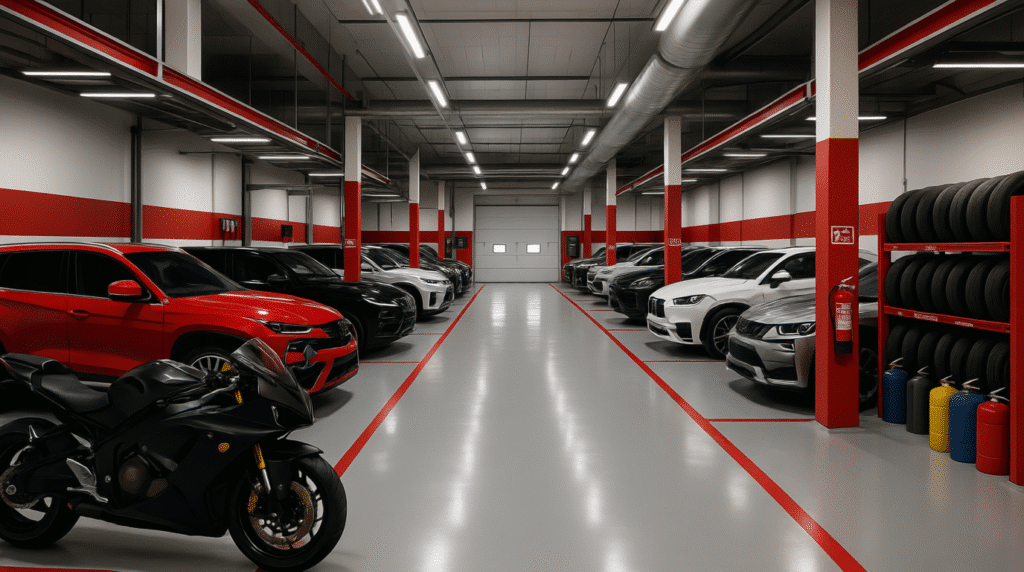
Essential pre-storage checks
To ensure that their motorcycles do not suffer any permanent damage, riders should use a checklist before they leave their bike parked during the summer:
- Proper cleaning: Clean the motorcycle by washing to remove dirt, sodium, and bugs. Dry completely to avoid rust.
- Oil change: The old oil is contaminated with corrosive engine parts. New oil forms a coating.
- Fluid tests: Fill up the coolant and brake fluid up to the guidelines. This eliminates dampness and breakdowns in systems.
- Fuel treatment: It is recommended to add a stabiliser to inhibit oxidation, especially with older carburetor models. Flick the switch on to warm up the engine.
- Battery maintenance: Do not leave the battery in the sun or rain. In place of this, attach it to a smart battery maintainer.
- Tyre pressure: Fill tyres up to the right amount of PSI to prevent flat spots. With longer storage, paddock stands can be used to raise wheels off the ground.
Equipment that makes a difference
The ride owners in the UAE do not attach much importance to the simple equipment. Especially, two things are important:
- Paddock stands: These hold the bike stable, in an upright position, and relieve stress on the tyres. During storage, they also provide ease in carrying out periodic checks.
- Good bike covers: Poor-quality bike covers trap moisture and are more destructive than beneficial. When used correctly, UV rays are blocked, dust is blocked, and the huts are ventilated. They also prevent accidental contact on metallic surfaces that lead to scratches during congestion in storage areas.
Short-term vs. long-term storage
Not all riders need the same level of preparation.
- Short-term storage (up to one month): A clean bike, inflated tyres, and a battery tender are often sufficient.
- Medium storage (1–3 months): Add fuel stabiliser, oil change, and cover.
- Long-term storage (more than 3 months): Full pre-storage checks, battery removal, paddock stands, and monthly inspections.
By tailoring preparation to the expected duration, riders avoid unnecessary work while still protecting their motorcycles.
Cultural and practical context in the UAE
The UAE has a thriving motorcycling culture with members who are daily riders on scooters and those who are collectors of vintage and old motorcycles. During the cool season, many expatriates ride, and during the summer, they travel home. Some have several motorbikes and store them throughout the year.
Proper storage of any such rider is not just about saving on repair costs. It touches on the safety and environmental respect, and protection of investment. Liquid spills, damaged batteries, and untied-down tyre piles can contribute to general hazards, particularly around residential car parks or business storage.
Final advice for riders
The first ride after summer is always considered to be the most dangerous. Check the tyres, brakes, and lights.
- When the engine is warm, start riding the high speed.
- Check the chain for rust and grease it.
- Changing any part with cracks, corrosion, or leaks.
With the right preparation, motorcycles that are parked during the summer seasons in the UAE can be on the road in fair condition, and they can give the same thrill and adventure that riders seek.
Final Conclusion
It is also much more complicated to store cars and motorcycles in the UAE than in colder weather. The dust and humidity, and heat increase the wear, and a compliance dimension is added by the stringent Civil Defence laws. Batteries should be taken care of and, when it comes to lithium-ion batteries, should be dealt with as hazardous material. More frequently neglected but containing actual fire hazards when stored carelessly are tyres. Vehicle fluids also need to be filled, emptied, or refilled to avoid a risk of damage and environmental risks. This is all founded on fire safety and extinguishers, together with training and compliance being non-negotiable conditions.
Summer storage is a seasonal need for motorcycle owners. With the help of the checklists, paddock stands and covers, fluid and battery demands, they can service their bikes and have pleasant rides when it becomes colder again.
Finally, it is not just about convenience when it comes to properly storing the vehicle in the UAE. It is regarding protecting investments, making sure they meet local regulations, and helping to make the world a much safer and cleaner place to live in.
